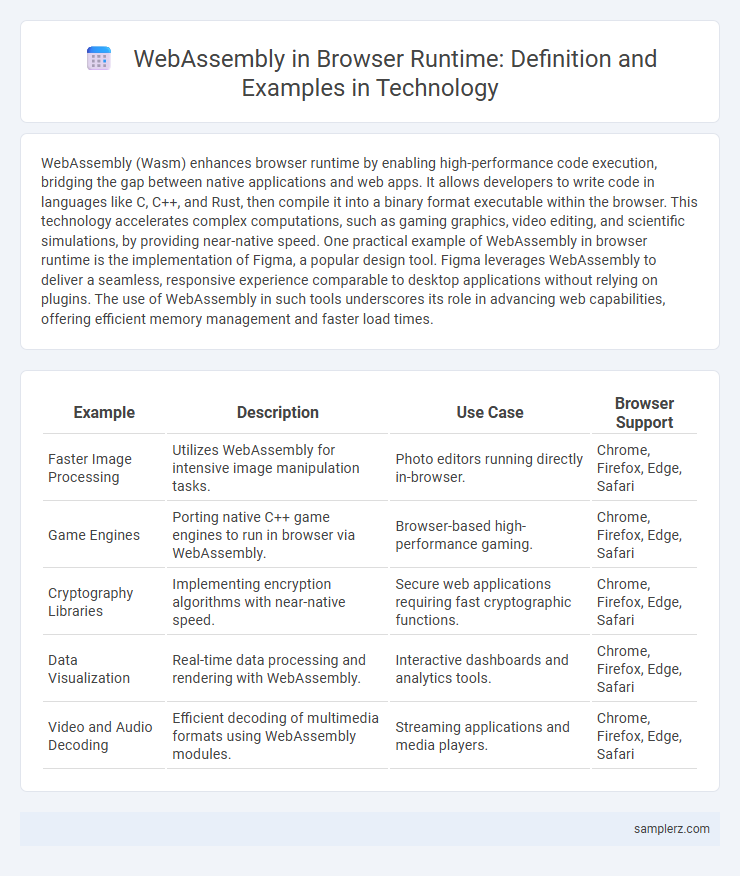WebAssembly (Wasm) enhances browser runtime by enabling high-performance code execution, bridging the gap between native applications and web apps. It allows developers to write code in languages like C, C++, and Rust, then compile it into a binary format executable within the browser. This technology accelerates complex computations, such as gaming graphics, video editing, and scientific simulations, by providing near-native speed. One practical example of WebAssembly in browser runtime is the implementation of Figma, a popular design tool. Figma leverages WebAssembly to deliver a seamless, responsive experience comparable to desktop applications without relying on plugins. The use of WebAssembly in such tools underscores its role in advancing web capabilities, offering efficient memory management and faster load times.
Table of Comparison
| Example | Description | Use Case | Browser Support |
|---|---|---|---|
| Faster Image Processing | Utilizes WebAssembly for intensive image manipulation tasks. | Photo editors running directly in-browser. | Chrome, Firefox, Edge, Safari |
| Game Engines | Porting native C++ game engines to run in browser via WebAssembly. | Browser-based high-performance gaming. | Chrome, Firefox, Edge, Safari |
| Cryptography Libraries | Implementing encryption algorithms with near-native speed. | Secure web applications requiring fast cryptographic functions. | Chrome, Firefox, Edge, Safari |
| Data Visualization | Real-time data processing and rendering with WebAssembly. | Interactive dashboards and analytics tools. | Chrome, Firefox, Edge, Safari |
| Video and Audio Decoding | Efficient decoding of multimedia formats using WebAssembly modules. | Streaming applications and media players. | Chrome, Firefox, Edge, Safari |
Introduction to WebAssembly in Browser Environments
WebAssembly (Wasm) enables high-performance execution of binary code directly in browser runtimes, supporting languages like C, C++, and Rust. It provides near-native speed and efficient memory usage, enhancing complex web applications such as gaming, image processing, and cryptographic algorithms. Integration with JavaScript APIs allows seamless interaction between WebAssembly modules and browser environments for optimized web performance.
Real-Time Image Processing with WebAssembly
Real-time image processing in browser runtime leverages WebAssembly to achieve near-native performance by executing complex algorithms directly within the browser environment. This technology enables applications like live video filters, object detection, and augmented reality to process and manipulate images instantly without server round-trips. WebAssembly frameworks such as OpenCV.js enhance performance and responsiveness, making sophisticated image analysis accessible on various devices and browsers.
Enabling Video Editing Tools in Browsers
WebAssembly empowers video editing tools in browsers by delivering near-native performance for complex processing tasks like real-time effects, transitions, and encoding. Popular libraries such as FFmpeg compiled to WebAssembly enable seamless video decoding and manipulation directly within the browser environment. This reduces reliance on server-side processing while providing users with responsive, high-quality video editing experiences without installing additional software.
Running Machine Learning Models Client-Side
WebAssembly enables efficient execution of machine learning models directly in browser runtime, allowing for real-time inference without server dependency. Frameworks like TensorFlow.js leverage WebAssembly to optimize neural network computations on client-side hardware, enhancing performance and reducing latency. Running ML models client-side improves user privacy by keeping sensitive data local and accelerates interactive applications such as image recognition and natural language processing.
WebAssembly for Interactive Games
WebAssembly enables high-performance execution of interactive games directly in browser runtimes by compiling game engines like Unity and Unreal Engine into compact binaries that run near-native speeds. This technology reduces load times and improves frame rates, delivering smooth gameplay experiences without requiring plugins or downloads. Developers leverage WebAssembly to create complex physics simulations, real-time 3D rendering, and multiplayer interactions within modern browsers, enhancing user engagement and accessibility.
Enhancing Cryptography and Security in Web Applications
WebAssembly enables high-performance cryptographic operations within browser runtime, significantly enhancing security in web applications by offloading intensive algorithms from JavaScript to a near-native execution environment. This improves the speed and efficiency of encryption, decryption, and hashing processes, crucial for secure data transmission and storage. Leveraging WebAssembly modules for implementing advanced cryptographic protocols strengthens resistance against common web vulnerabilities such as timing attacks and side-channel exploits.
Accelerating Data Visualization and Analytics
WebAssembly enables near-native performance for complex data visualization libraries like D3.js and Plotly within browser runtimes, significantly accelerating rendering speeds and interactivity. By compiling computationally intensive analytics algorithms into WebAssembly modules, applications achieve faster data processing and reduced latency compared to traditional JavaScript execution. This performance boost enhances real-time analytics and dynamic user interfaces in web-based business intelligence and scientific visualization tools.
Compiling Legacy Code for Modern Browsers
WebAssembly enables the compilation of legacy C and C++ code into a performant binary format that runs efficiently within modern browser runtimes. Projects like Emscripten facilitate this process by translating existing codebases into WebAssembly modules, allowing complex applications such as games and image editors to operate seamlessly in the browser. This technology bridges the gap between traditional native software and web environments, enhancing browser capabilities without sacrificing speed or functionality.
Improving Audio Processing and Synthesis
WebAssembly enables high-performance audio processing and synthesis directly in the browser by leveraging near-native execution speed. Libraries like AudioWorklet and frameworks such as WebAudio-Wasm utilize WebAssembly to handle complex audio computations, including real-time signal filtering, synthesis, and effects processing. This approach reduces latency and CPU load compared to JavaScript, enhancing interactive applications such as digital audio workstations and immersive sound experiences.
Boosting Performance of CAD and 3D Applications
WebAssembly significantly enhances the performance of CAD and 3D applications in browser runtimes by enabling near-native execution speeds and efficient memory management. Complex computational tasks such as real-time rendering, mesh processing, and physics simulations benefit from WebAssembly's low-level capabilities, allowing smoother interactions and faster load times. Leading platforms utilize WebAssembly to deliver rich, high-fidelity 3D experiences directly in browsers without sacrificing speed or responsiveness.

example of webassembly in browser runtime Infographic
 samplerz.com
samplerz.com